Sow Sow Yummy!
The sun is shining (or at least it was when I wrote this, it is probably snowing now knowing Scotland!) so it’s the perfect time to sow vegetables in the garden. Don’t know what to do? Well, lucky I am here to show you how and to tell you about some wonderful tools I used along the way…
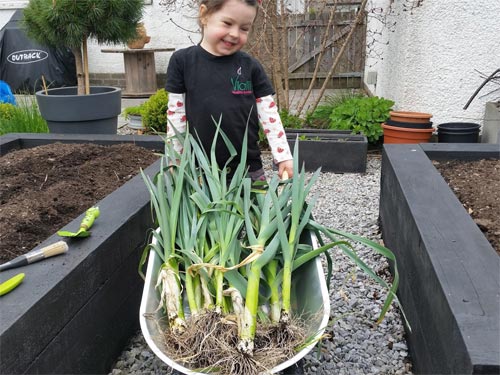
Soon you could have a barrow full of amazing leeks just like mine!
WEED YOUR VEG PATCH
It’s important that you have a weed free veg patch and that you have good quality soil. Add some new compost or fertiliser if you need to.
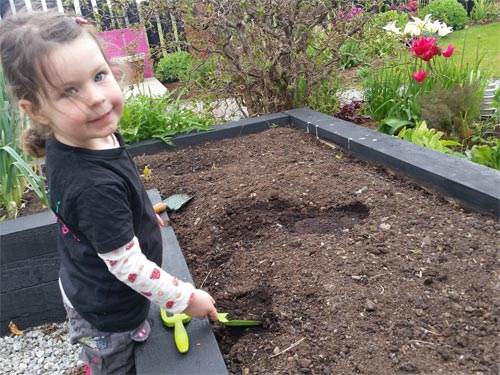
Weed your veg beds before you start sowing your seeds
PREPARE YOUR BED
Once you are weed free, take a few minutes to make sure your veg beds are nice and flat and even. It’s a bit like making your bed in the morning, you have to make it nice and neat and ready for bedtime! I used my Twigz rake, perfect for this job. Maybe not so much in your real bed though!
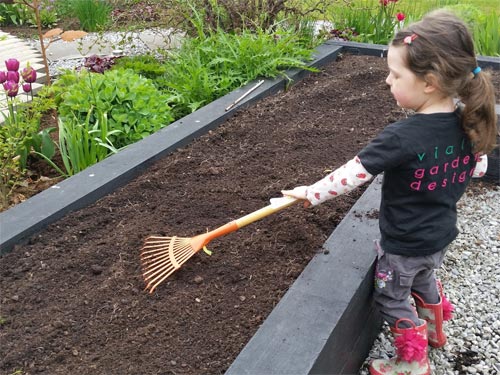
Rake out your veg beds and make the nice and even
MAKE A DRILL
Not the tool kind silly! It’s a little line in the soil where you can sow your seeds into. Use a cane to help make sure your row is nice and straight.
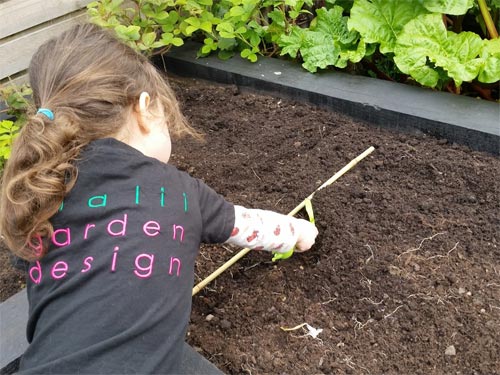
Make a row to sow your seeds into
SOW YOUR SEEDS
Carefully pour some seeds into your hand and sprinkle them into your row, making sure they are evenly sown. Gently cover them over and water them in. If you are sowing seed potatoes or onion sets, gently push them into the soil to the depth stated on the instructions.
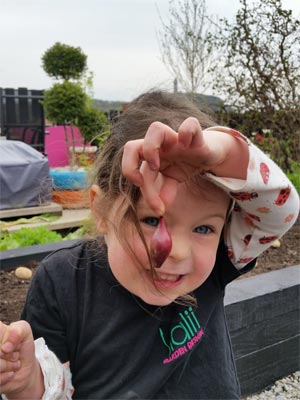
This ickle onion will grow nice & big, just like me!
KNOW YOUR ONIONS
It’s important to remember what you have planted where – you don’t want to be making chips out of your shallots – so make sure you carefully write your vegetable names on a plant marker. I like to draw a picture too – here’s my rocket!!

Zoom zoom, a rocket!
Now you just need to sit back and watch your seedlings pop up. You will need to “thin them” which means removing some of the smaller seedlings and give some bigger ones space to grow. Keep your seedlings water and weed free and before you know it you will be picking fresh veg straight from your garden.
TOOLS
Good tools are the back bone of any good gardener and I have found some wonderful ones to use in my garden. To do all of the above I used:
- Twigz tool set (to weed and mark out my drills) £19.99*
- Twigz rake (to make sure the veg beds were nice and flat) £8.99*
- Twigz watering can (to water all my lovely wee seeds in with) £10.99*
- Twigz wheelbarrow (to barrow away last year’s leeks I dug up!) £49.99*
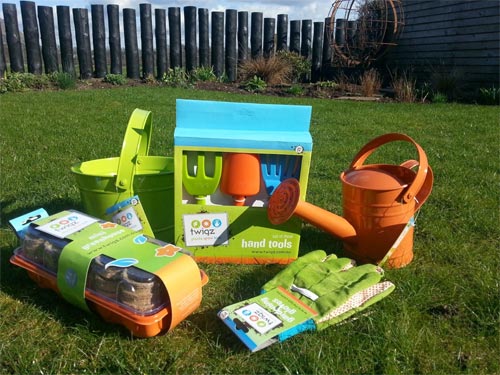
Twigz do a wonderful range of garden tools for children
I thoroughly recommend the Twigz range of gardening tools for kids. They are great quality and can even last the rigours of a professional like me! They are a little pricier than some alternatives but the quality and durability makes it worth it. They get a big green thumbs up from me!
For more seed sowing inspiration read my other blog Sowing The Seeds of Love.
Love Lulu xx
*Price correct at time of publication
Hop To It: Save The Frogs Day 2016
This Saturday, 30th April 2016, is Save The Frogs Day. So, as a keen wildlife gardener I have some great tips on pond dipping and some froggy facts about midgies, drinking water and much more…
Last weekend, I visited Jupiter Urban Wildlife Centre in Grangemouth. If you haven’t been already, you MUST go as it is really awesome. Partly because my clever M&D redesigned the gardens (they are def worth a visit and one is even made from old rubbish!) But mostly ‘cos they are cool people there, who do a wonderful job encouraging wildlife in the middle of an industrial estate and they let you borrow all sorts of kit as well as giving you sheets telling you what to do.
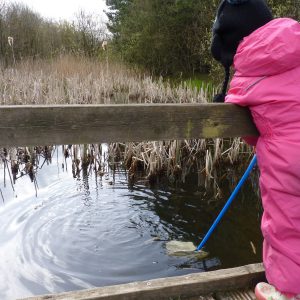
Perfecting my “Figure of 8” motion at Jupiter
I took Tilda along for a visit on Saturday as she hasn’t been there before and to show her how to go pond dipping. For pond dipping you will need:
- A shallow tray, preferably a light colour so you can easily see what you find
- A magnifying pot or glass so you can get a close up view of your little critters.
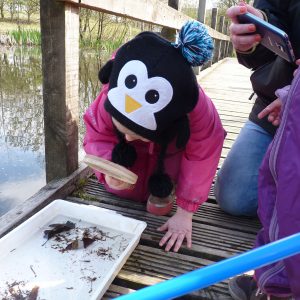
Inspecting my find with my Bigjigs magnifying glass
How to pond dip
- Ask an adult to fill your tray with some pond water
- Gently put your net in the water and move it in a figure of eight motion for about 20 seconds
- Gently empty the contents of your net into your tray
- You will often find more pond life around the plants in the pond as they like to shelter there
- Never stretch and always make sure you are comfortable when you are “fishing”
- Always take a responsible adult with you when you go pond dipping

The magnifier is great for seeing pond-life close up
When we went pond dipping we found:
- Water snails
- Damselfly nymphs
- Lesser water boatmen
- An ickle minnow
I had hoped to find some frog spawn or tadpoles but there were none to be seen. Luckily we have a tank full of tadpoles at our nursery. We had collected frog spawn and we have already seen it turn into tadpoles. I can’t wait to see them turn into frogs!
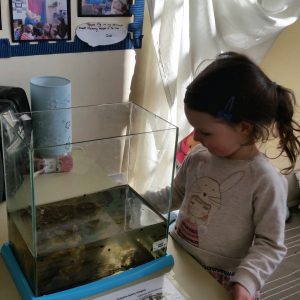
So, why are frogs so important?
Well, here are few quick facts:
- Frog spawn tastes awful (so I am told) thus protecting the eggs from being eaten by predators
- Frogs lay up to 4000 at one time (that’s a lot of brothers and sisters!)
- Amphibian means two lives
- Our froggy numbers are declining really fast
- Nearly 1/3 of the world’s amphibians are threatened with extinction
- We need frogs to keep our eco-system stable
- Frogs eat mosquitoes (or more importantly for us in Scotland, midgies!!)
- Frogs help in medical advances
- Frogs are food for birds
- Tadpoles help filter our drinking water
- Scientists have found frog fossils dating back over 140 million years ago (almost as old as Daddy!)
So, what can you do to help save the frogs?
- Pop over to Save The Frogs to make a donation or read about other ways to help such as volunteering
- Support organisations such as the Scottish Wildlife Trust who run Jupiter Urban Wildlife Centre
- Don’t eat frog’s legs (to be honest that one is pretty easy for me, I mean, really, would you???)
- Don’t use pesticides (we very much recommend organic gardening anyway)
- Introduce a small frog pond into your garden or somewhere in the local community.
That’s all from me. Ribbit!
Lulu xx
Prices correct at time of publication
National Gardening Week 2016
Today is the start of the 2016 National Gardening Week and to celebrate I have collated my eight favourite things I recommend that you do this week…

Get outside and have fun this National Gardening Week
Get Painting
I love all kinds of painting and this is the perfect time of year to get your garden looking spick and span. From fences and veg beds to playhouses and sand-pits, get outdoors and not only make everything look nice but keep it protected for another year.

My playhouse is lovely and fresh ready for a summer of play
Top dress your borders & pots
Like us, plants need nutrients to keep them healthy and growing strong. To do this we need to add compost to the garden and guess what else? Poo! Yes, actual poo! Not ours of course, farm manure. Well, I am going to leave that part to daddy! Poooeeeeee!!
Go visit a new garden
It’s always great to go visit a new garden and there are some amazing ones all over the UK. If you’re in London, go visit the new Magic Garden at Hampton Court. The RHS gardens and the Botanic Gardens are always worth a visit. More locally the maze at Scone Palace is a-maze-ing! And in a few weeks it will be the annual open day at the Garden of Cosmic Speculation. To read M&D’s list of their favourite gardens to visit, click here.

The gardens at Levens Hall in the Lake District are well worth a visit
Plant a new veg
You don’t need much space to grow veg. Why not try growing a courgette in a pot on your back door step. Or some tumbler tomatoes in a window box. It’s cool to watch them growing and yummy to eat. Go on, try one this year and see how it goes…
Spike your lawn
Spiking your lawn is a great way of getting air into a compacted lawn and letting the grass grow better (rather than just moss, thatch and weeds!) Try that as well as some lawn feeds and scarifying to get your grass in tip top condition for the summer.
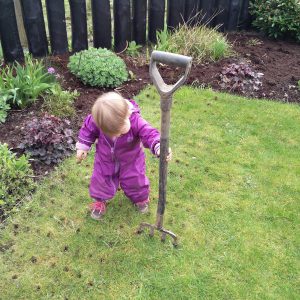
Tilda helps spike our lawn
Sow wildflowers
There are always organisations giving out free packets of wildflowers to take advantage of. Use them in a quiet corner of your garden or see if you can find a piece of local wasteland which you can cheer up this summer.
Play a garden game
We are lucky to have a wonderful range of garden games from BigJigs which we will be featuring soon in one of my blogs. From crazy golf and skittles to quoits and croquet, there is a great range of fun games to invite your friends round to play. Or, of course, the old favourites of hide ‘n’ seek and tag are fun garden games and don’t cost a penny.

Anyone for a game of croquet?
Make mud soup
This is currently my favourite garden activity. Anything can be added to mud soup (herbs, sand, water, stones, you name it) but the base ingredient is, of course, mud! Mummy recommends rainsuits and wellies for this game!
For more information on National Gardening Week please click here.
Hopefully you will do at least ONE of these activities during this year’s National Gardening Week, but wherever you are and whatever you do I hope you really do love your garden.
Lulu xx
Easy To Grow Veg That Are Hard to Buy
In my recent blog I told you the ten EASIEST Spring veg to grow. This time I am going to add to that list with veg which are still easy to grow but really DIFFICULT to buy in the shops. So while your potatoes and salad will be the freshest in the street you can now further impress your friends with these tasty treats, many of which they will never even have heard of! Ulluco anyone?
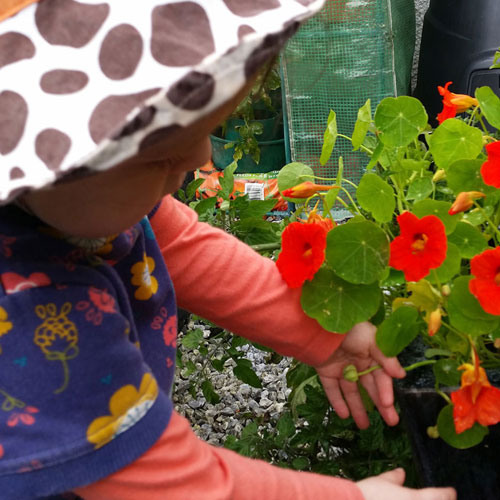
Nasturtiums are easy to grow and taste and look great
Oca
Not to be confused with Okra, Oca is a slightly tangy root vegetable which tastes amazing in salads. They are also called new Zealand Yam and were originally brought into cultivation in South America. We love them best raw in salads but you can also treat them like a potato and boil, grill or fry them! My BFF Euan is great at growing these in his garden! They are frost hardy so don’t plant them outside until all risk of frost has passed.
Ulluco
Another favourite of Euan’s and the South American’s, ulluco is second only to the mighty potato in the Andes. They can come in lots of amazing colours too like purple, green and yellow so I have renamed the rainbow potatoes! You can use them like potatoes too except don’t fry or bake them due to their high water content. They are great boiled though and keep their crunch! You can also use their leaves like spinach. Like oca, plant them like potatoes and once frost has gone.
Sorrel
Sorrel is a yummy herby addition to your larder and difficult to buy in the shops. It’s easy to grow in a pot on the patio and you can use it in salads, soups and sauces or with fish and egg dishes. It has a sharp taste so use smaller leaves when using it raw.
Edible Flowers
There is little prettier than sprinkling edible flowers over a salad and serving that on a lovely summer’s day. But where on earth do you buy edible flowers from? Well you don’t, you grow them. We always grow nasturtiums in our garden as they are great for combination planting with vegetables as well as being pretty. They are also the easiest plants to grow and it’s fun to collect the seeds at the end of the summer for free plants the following year. The pretty petals have a lovely peppery flavour but you can use the leaves and buds too. The RHS has lots of information on other edible flowers but make sure you check with an adult before eating any flowers in your garden as LOTS are toxic.
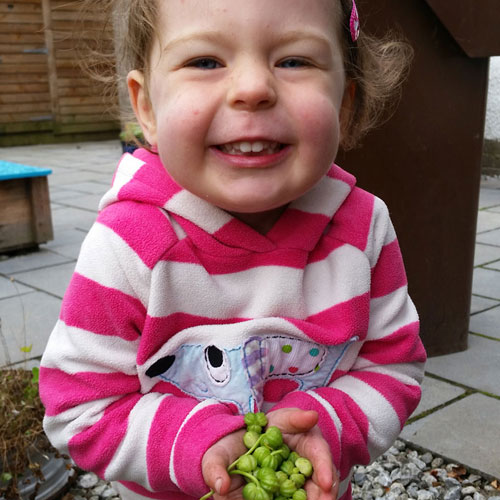
Collecting nasturtium seeds for next year is really easy!
Fennel
Fennel is one of the easiest plants to grow and we have it dotted around our flower beds as we love it’s feathery foliage. But if you love the aniseed taste from it’s root and can’t get a hold of it in the shops then try growing it yourself. It’s a super easy to grow perennial. Plant it in your veg patch or around your garden and it will happily grow away itself.
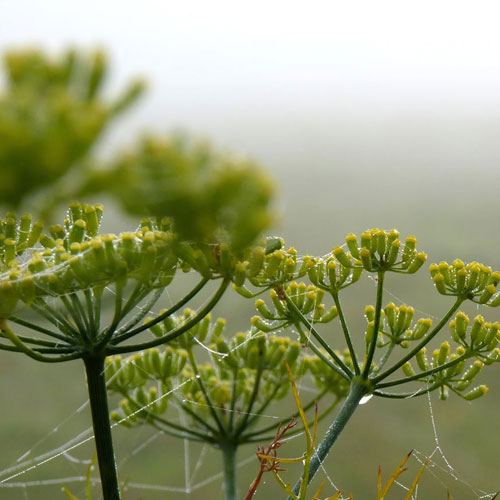
Fennel seed heads look amazing in the garden if you haven’t already scoffed the root vegetable
Chard
This was on my list of easy veg to grow and makes it onto the hard to buy list too. It really is super easy and looks sooooo lovely and colourful in the garden. Sprinkle a few seeds in your veg patch or grow in pots and transplant outside into the garden later. It is one of the healthiest vegetables in the world and both the leaves and stems can be used.
Other favourites which are easy to grow but hard to buy include courgette flowers, cucamelons, lemon verbena, tomatillos (if you get enough sun!) and kohlrabi.
Have fun growing and eating your funky veg!
Lulu x
10 Super Easy Spring Veg To Grow
Saturday 19th March is the Spring Equinox and officially the first day of Spring yippee. That means sunnier days, lighter evenings and most importantly more time to play in the garden! It also means it’s time for me to get busy growing veg again so to help you along, here are my TEN easiest Spring veg to get growing…
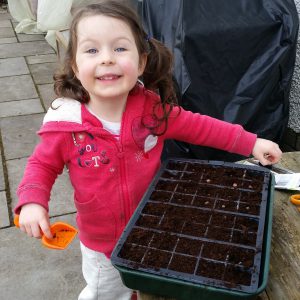
Here we grow!
Before you start to grow any veg, take a minute to remove any weeds or large stones from your veg beds and give them a wee hoe over. If you haven’t already added a soil improver over winter now is a great time to add some nutrients to help your veg grow big and strong (just like me!). Done? OK, let’s go…
1. BEETROOT
This is one of my favourite root vegetables to grow as it is super-duper easy. Beetroot prefer a well drained soil so add some sand if yours is a bit sticky. Now, just sprinkle some seeds in a long row and gently cover. As the seedlings come through thin them out to allow big juicy beetroot to grow.
2. SALAD
Now under the heading of “Salad” I am covering lettuce leaves, rocket and spinach as they are all equally easy to grow. I especially love the “cut and come again” salad leaves as they just keep on growing the more you eat them. Wowsers!
3. RADISH
You have got your salad growing so you will need some radish growing with it. The best thing about radish is how quick it grows. Within a few days you will see it popping up. Sow successional rows so you always have radish to eat.
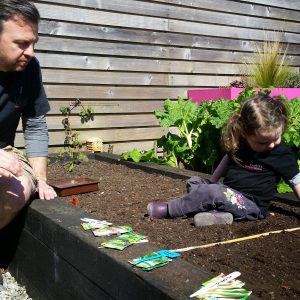
Prep your soil then sow your seeds in a nice neat row
4. PEAS
Another easy-peasy (ha, see what I did there?!) veg to grow and yummy to eat (it’s one of Tilda’s favourites!) If you don’t want to train big tall ones up lines then opt for a dwarf bush variety. I love popping the peas out of their pods!
5. POTATOES
An absolute staple in our garden and super easy to grow. Buy some seeds potatoes and let them chit on your window sill for a couple of weeks before burying them deep in your veg patch. Cover over the leaves as they pop through (this is called “earthing up”) and you will have a yummy batch of tatties come summer!
6. ONIONS
Another easy one, just buy onion “sets” which are teeny weeny onions and plant them in your veg area. They will soon grow into much bigger onions for you to pick.

Teeny weeny onion sets!
7. SWISS CHARD
Not only is swiss chard super healthy (it is full of vitamins and minerals) but it is also soooooo pretty. As well as growing it in your veg patch you can grow it in your flower beds where its colourful stalks will be a lovely addition to the garden.
8. TOMATOES
If you are an expert like me then you can grow a wide variety of tomatoes in your greenhouse. But here’s a secret tip, choose a “tumbler” or “bush” variety and they will be super happy growing in a pot in a sunny corner of your garden. The bonus is you don’t have to “pinch out” this type of tomato or tie them up as they grow. And they will give you the most delicious cherry tomatoes you have ever tasted! And much easier than going to the supermarket to buy them!
9. COURGETTES
This year I am growing both green and yellow courgettes. I have planted the seeds in little trays in the house and when they are a LOT bigger I will plant them outside in big pots where they will give me lovely courgettes all summer long. I’ll need to be fast though to beat the cheeky snails who love them too!
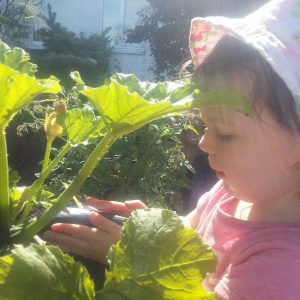
Here I am checking for courgettes
10. SPRING ONIONS
Well it wouldn’t be a Spring veg blog without a Spring Onion would it? Like beetroot, just sprinkle some seeds in a line and thin out the seedlings as they come through. Couldn’t be easier!
Happy growing readers!
Lulu xx
Book Review: Usborne Garden Sticker & Colouring Book
As you know, I am an expert on all things gardening. And I am pretty good at sticking and colouring too so I was the natural choice to give my expert opinion on Usborne’s latest book, handily called “Garden Sticker & Colouring Book”. But did it reach my high expectations or did it crash into a sticky, scribbly mess?…
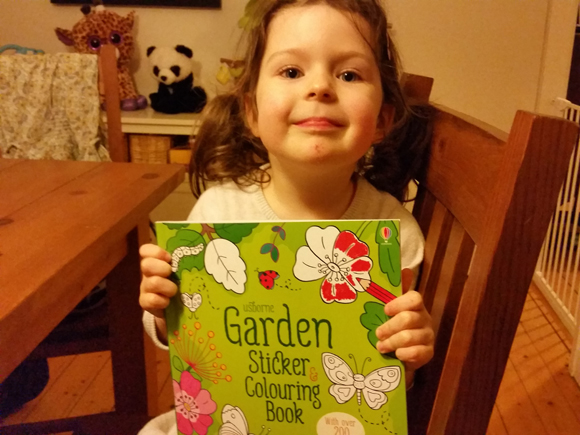
A brand new book from Usborne, but what did I think of it?…
Well, if you are already a fan of Usborne books like me, you will know that they know how to make a good book and, to be honest, this one doesn’t disappoint. Here are some of my favourite things about the book:
It’s got loads of pages in it. 32 to be precise so it will last for AGES!
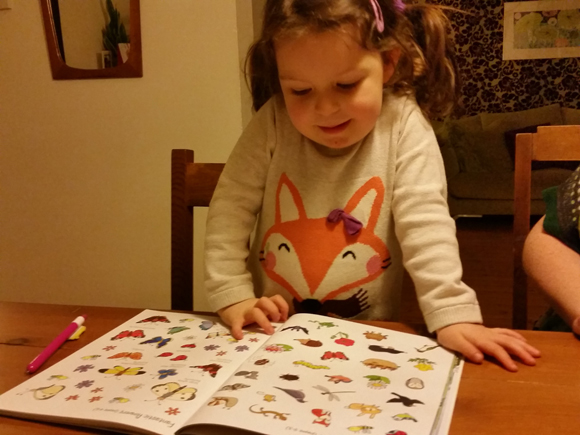
Wow, there are a LOT of stickers to choose from!
The stickers are brilliant quality. I have some sticker books where the stickers are hard to get off and rip easily. These ones are much better quality and have a nice glossy feel to them.
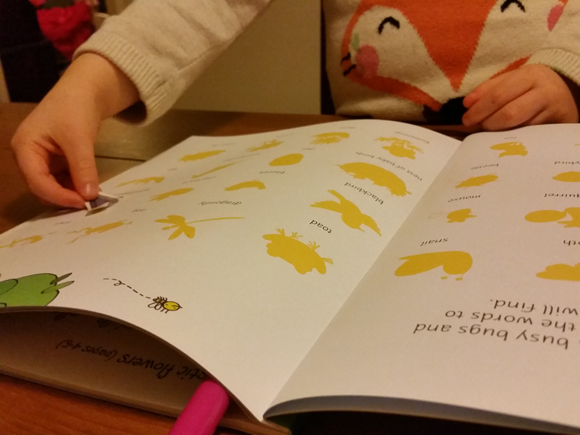
Adding the bugs to their silhouettes was LOTS of fun
At the back of the book there are lots of bits to colour in which makes a nice change from just sticking. I love sticking but after a while it’s nice to do some colouring too. Plus I like that the flowers were proper flower shapes and not just a generic flower. There were foxgloves and echinacea and poppies and all sorts of pretty plants to colour.
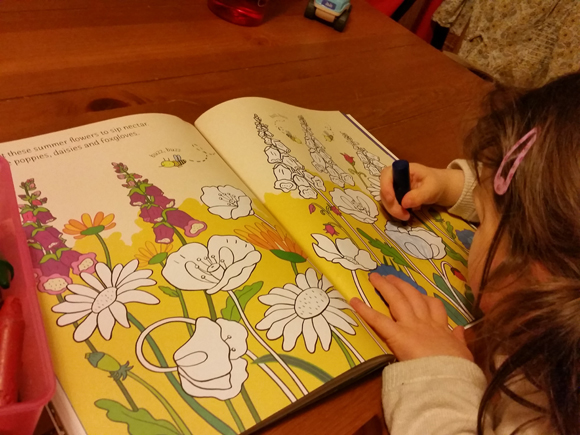
Lots of pretty flowers to colour
There’s lots to learn in this book. It tells you the names of lots of bugs and birds, vegetables and some of the animals that come out at night (like Batty the Bat!)
They even have Primula vialii growing beside the pond in one of the pictures. This is the plant that our family business Vialii Garden Services is named after. Cool!
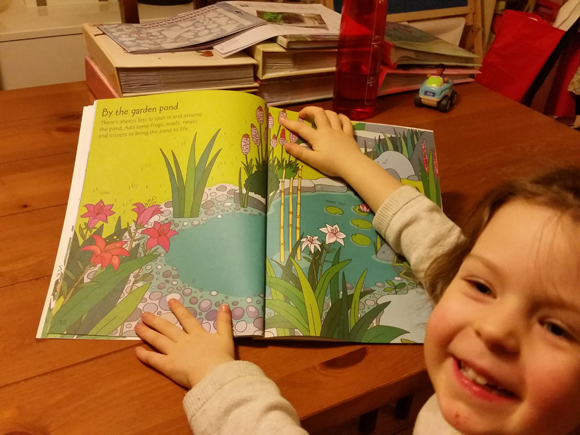
Look, a Primula vialii which is what our company is named after!
The book costs £7.99 which I think is AMAZING value for a book which will give many, many hours of fun. I have spent loads of time colouring and sticking and there is still lots to do. So for those rainy days when you can’t get outdoors in the garden then what better than to snuggle down with this book.

It gets a big thumbs up from me!

Available from Usborne Books and all good book sellers.
Hope you love it as much as me!
Lulu xx
Introducing the Foody…
We were sent a weird but wonderful new contraption through the post this weekend and I had lots of fun showing M&D how to build it (they needed an expert like me to keep them right). Read on to find out what it is and what we are going to be doing with it…
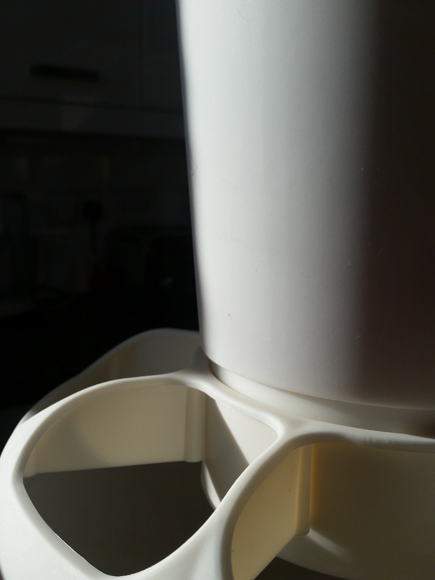
What in the world could this bed? A space ship?
A cup holder? Read on to find out more….
The Foody is a vertical growing system designed to provide the perfect environment to grow herbs, salads and flowers. It also only requires 10% of the water used in a traditional garden and can be used indoors or outdoors.
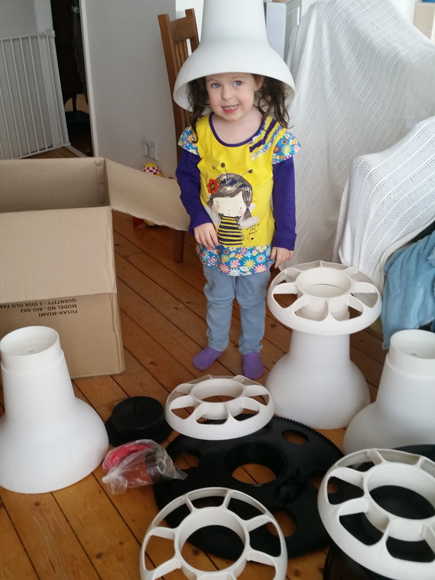
It’s a funky hat, that’s what it is!
But Lulu, how does it work I hear you ask? Well, when you water the top pod the water slowly drains down to the reservoir in the bottom. Cleverly, there are six extra pots down there with wicks which can use this water too.
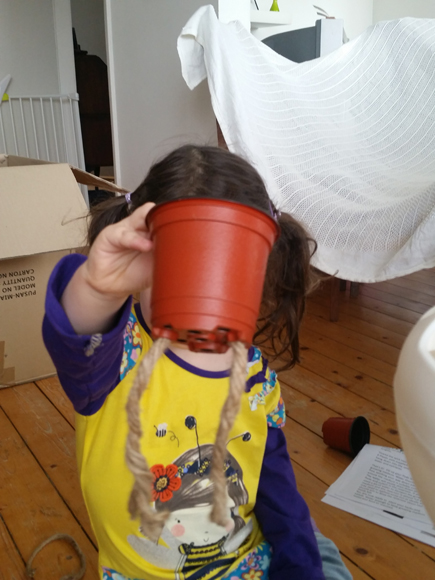
Lookee here, there are pots at the bottom and the
rope acts a wick to sook up all the water from below
As it can also be used indoors (and it looks pretty cool too) it means you can be growing salads and herbs all the year round, even up here in chilly Scotland!
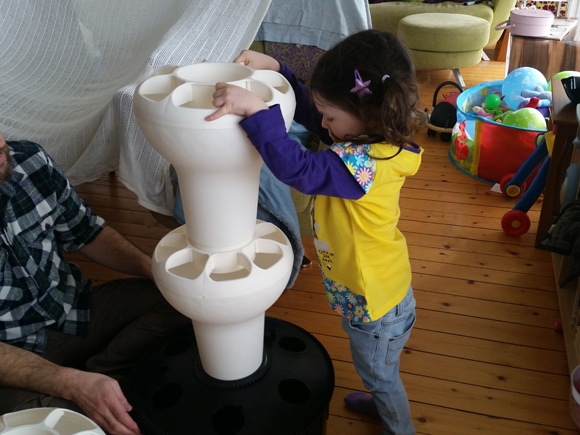
I start to add the towers on to our reservoir. You can choose a
Foody 3, 4 or 5 which have different levels to suit you
And if you really want to, you can even add a pump so that the watering is done automatically (watering is one of my favourite parts though as I get to splash in the water and look for fruit and veg at the same time!)
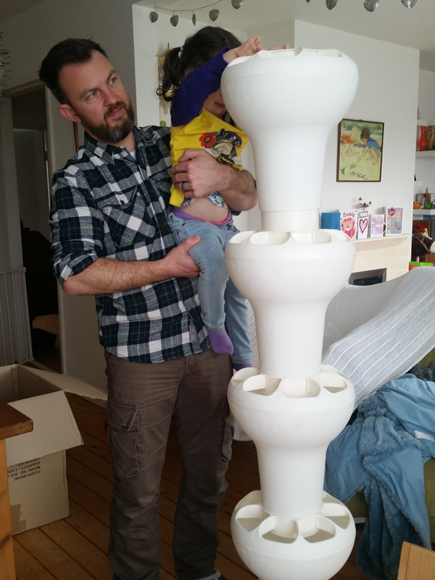
Wow, it’s getting tall now, I need a
little hand to reach up to add this pod!
The Foody is perfect when you have limited space and can be used in greenhouses, balconies, roof terraces, patios, you name it. And it cleverly rotates too so that you can make sure all sections get their share of the sun as required.
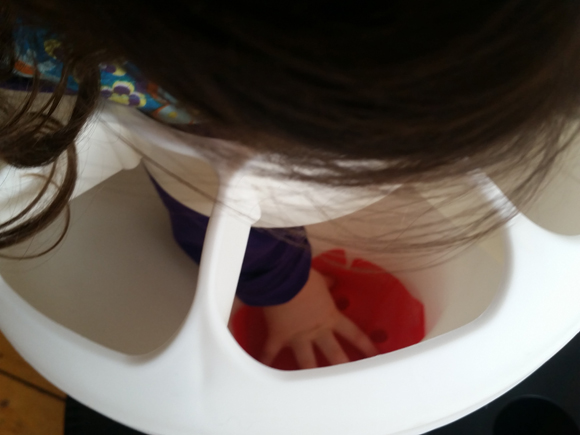
You get some material to add to the bottom of each pod to stop
any soil being washed down through the drainage holes
And as you can see from the pics it is super easy to put together. We’ll be trialing a selection of fruit and veg in our Foody 5 (you can grow all sorts in them and I will be growing strawberries, tomatoes, radish and tomatoes to name just a few) over the coming months and will keep you posted of our results.
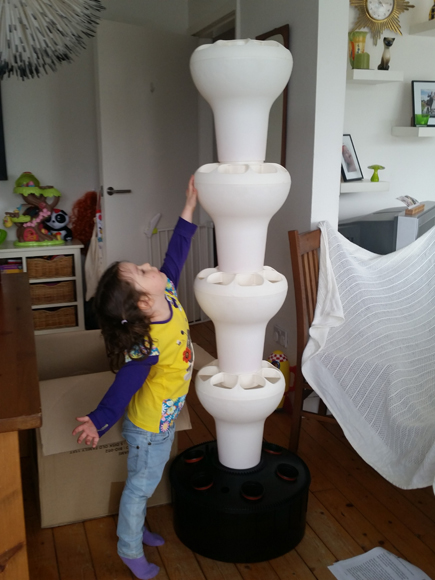
Wow, our Foody 5 is waaaaay tall!
For more information on the Foody go visit the lovely people over at LIFE.

Plus you get a free box for hours of fun!
Lulu xx
Sow Clever: Upcycled Seed Trays
It’s the perfect time of year to start growing veg from seed (let’s face it the weather isn’t really good enough to be outdoors all day just yet so sneaking indoors to do some seed sowing is a good thing!) But you don’t need expensive seed trays or propagators. Literally have a look around your house and you will find plenty ideas for free seed trays to use and sow clever…
Toilet roll tubes
We all have loads of these. We normally use them for craft projects but they make excellent planters for seeds. Cut them down a bit in size (you could easily make two pots from each tube) and sit them on a tray and fill with compost. Easy peasy.
Egg shells
You can even grow seeds, such as cress, in egg shells. Look at the funny haircuts above!!!
Egg cartons
And nothing need go to waste with an egg. We have used the egg shell and we can use the carton too. Perfect for growing seeds in.
Milk or juice cartons
Any sort of carton can be cut open (ask a grown up to do that bit) and filled with compost. Wonder if I can grow oranges in an orange carton?…
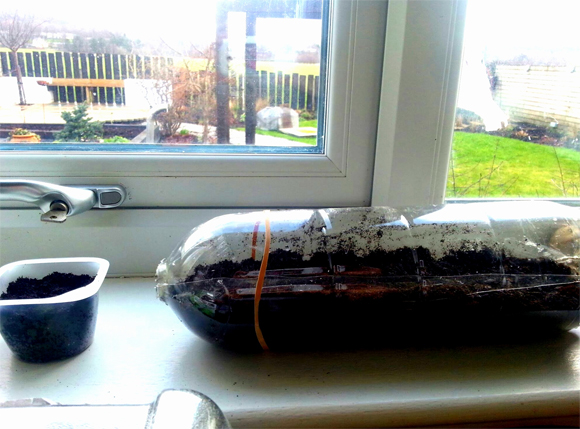
We grew some brilliant broccoli in this juice tray!
Paper cups
Get your mummy and daddy to save their coffee cups and recycle those party cups too. Perfect for growing veg.
Newspapers
Newspapers can be folded up to make little cups for growing seeds in. These are brilliant as they decompose in the ground so you don’t have to upset the teeny roots by taking them out of their pot.
Ice cube tray
Another great alternative to a seed tray. Just make sure you don’t pop it back in the freezer!
Bottles & Pots
Old juice bottles or yoghurt or custard pots are other great ways to sow seeds. The bonus of using a juice bottle is that you can make a lid which then keeps the heat in and makes the seeds grow faster!
So there you go, not only do you save money on the veg you are growing you don’t even need to spend any money on pots to grow them in. Veg-tastic!
To learn more about how to grow seeds in any kind of tray then read my blog here.
Happy sowing,
Lulu xx
Lulu v Hedgehogs. Who will be the winner?
Today is doubly important. Firstly, and arguably most importantly, today is my 4th birthday! Hip hip hooray! But, spare a thought for my spiky friends, the hedgehogs, as it is National Hedgehog Day today. As it’s both our special days, my latest blog is how to care for us both! I wonder who will be the highest maintenance…

Happy Birthday to me!
Making a Home
Hedgehogs are pretty low maintenance when it comes to their home, they just want a quiet corner of your garden with a pile of leaves and some logs. If you are feeling generous you can buy a bespoke hedgehog house. Lulus are slightly more demanding when it comes to a home. We like a proper roof, a cosy bed, some toys and even a TV to watch! I wouldn’t be happy if I had to sleep in a leaf pile!
Result: Lulu’s are definitely higher maintenance when it comes to a home!
Keeping Us Safe
Hedgehogs have little fear of danger and you need to watch out for potential dangers in your garden such as holes or drains that they might fall into and keep them covered. If you have a pond make sure it has at least one gently sloping side to it so hedgehogs can escape if they fall in. Lulus also have to be super careful of danger but I know my green cross code and not to speak to strangers. I sometimes fall into holes but normally they are just little and I can get myself out. I reckon I am a bit more streetwise than your average hedgehog!
Result: Hedgehogs are not as savvy as Lulus so I win this one!
Feeding Time
Food and fresh water will encourage hedgehogs to return to your garden. They love stuff like cat and dog food (but not fish based foods) and fresh water. Never give them milk though as it gives them sore tummies. Yuck, please don’t give me cat food for dinner, that is definitely for my cat Fudge. And I really like fish (and chicken curry and pasta and pancakes, though not at the same time!) so I think I may be a little bit more high maintenance on this front. I agree on milk though, I don’t want to drink that either Mr Hedgehog!
Result: I think it takes a lot more work to feed a Lulu!
So, overall, it looks like I am more high maintenance than a hedgehog but I am cute too and not as spiky so I reckon that’s OK.
Happy Hedgehog Day and Happy Birthday to me!
Lulu xx
Secret Squirrels
Some gardeners detest them for eating their favourite plants and bulbs while others love to see them perform acrobatics in their garden. I am definitely in the second camp but if you want to learn more about squirrels (well it is Squirrel Appreciation Day on 21st January 2016 after all) in your garden then read on. I have some really cool facts about chilli and acorns!
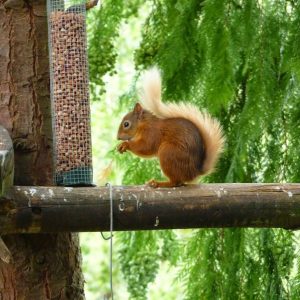
Squirrely facts
- There are two types of squirrel, the red squirrel and the grey squirrel.
- The scientific name of the grey squirrel is Sciurus carolinensis. The red’s posh name is Sciurus vulgaris.
- Squirrels like to eat many ornamental plants, fruits and vegetables (hence the issue for some gardeners but mummy says it’s nice to share)
- Contrary to popular belief, grey squirrels do not attack or kill red squirrels. They do take over their natural habitat though and as the greys are more competitive the number of red squirrels are in decline. Both types of squirrels can cause damage in gardens though.
- Grey squirrels have twice the body mass of the red squirrel, hence their dominance!
- Grey squirrels love acorns but reds find them mostly indigestible. Who knew?!
- A squirrel’s nest is called a drey
- Other than a few small areas of Italy, the grey squirrel is not found in Europe outside of the UK and Ireland. The red squirrel, however is found extensively around Europe.

How to protect against squirrels:
- Use netting to protect your plants, fruit, bulbs etc.
- Use squirrel proof bird feeders/tables etc so they are not attracted into your garden by your bird food.
- Hang old CDs and other creations which will make a noise and deter them.
- Set up decoy food stations – if you have yummy food on offer to them chances are they will leave your prized flowers alone.
- Get a pet – squirrels don’t much like cats and dogs and will often go elsewhere.
- Add chilli powder or Tabasco to your bird food; birds don’t mind it but squirrels do!!
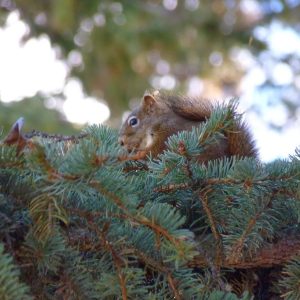
Turn Over A New Leaf for 2016
Happy new year peeps! It’s that time of year when we are all making new year’s resolutions. Some are vast and some are teeny. Make them realistic is what I say. So with that in mind Family Burt have made their new years resolutions for 2016 and have made them super-easy, garden-related ones to inspire you to get outside in the year ahead…
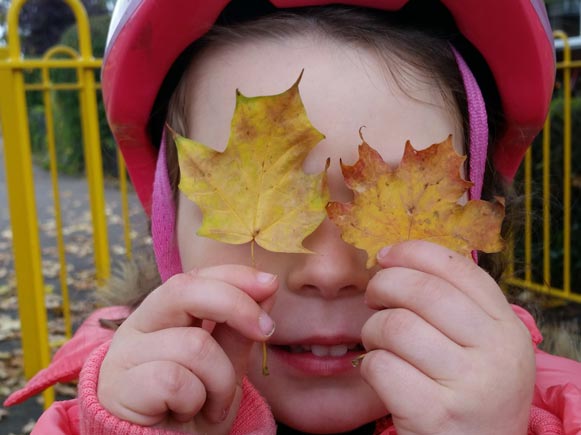
Time to turn over a new leaf
Lulu’s Resolution
Well, I LOVE eating fruit! My friends think I am crazy as I would rather have an apple than sweets but, you know, that’s because I’m sweet enough! So this year, my resolution is to grow a new fruit. I am thinking a little pear tree would be cute and I could grow it in a pot. But you could grow all sorts of fruit no matter what space you have. Already we have apple and plum trees but if you have less space why not grow blueberries and gooseberries in pots like me. Or if there is a corner of your garden that no-one uses why not pop a raspberry plant in there and by summer you will have lovely lush fruit. Yum!
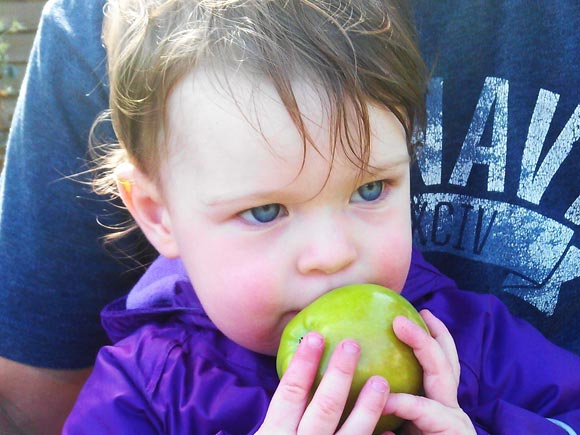
I’ve always loved eating the apples in our garden
Mummy’s Resolution
Well, you are gonna just love Mummy’s resolution for this year. It’s to keep it simple in the garden! With a new extension on the horizon (yup, I have THAT many toys!) 2016 is going to be super busy. So instead of growing lots of plants indoor from seed, transplanting, getting the greenhouse going and so much more, Mummy is focusing on the basics. There will be tatties and onions galore (‘cos they are easy to grow and we eat lots of them!) as well as some other easy veg like beetroot and salad.
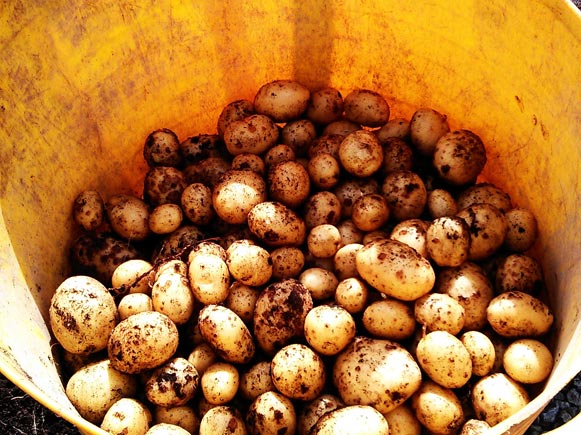
Mummy is going to grow more yummy potatoes like these in 2016
Tilda’s Resolution
My baby sister is almost walking now and by the time Spring is here she will be running around the garden. So her resolution is to get outdoors as much as she can and learn all about nature and feel the grass under her toes. From snail races to bubble popping the garden is going to be so much fun for me and Tilly B this year!

Tilda is planning on lots of outdoor fun in 2016
Daddy’s Resolution
With our impending extension Daddy will have to make some changes to our outdoor space. The garage is being demolished and will need to be emptied so Daddy is taking that opportunity to do some more upcycling including new sheds for garden storage.
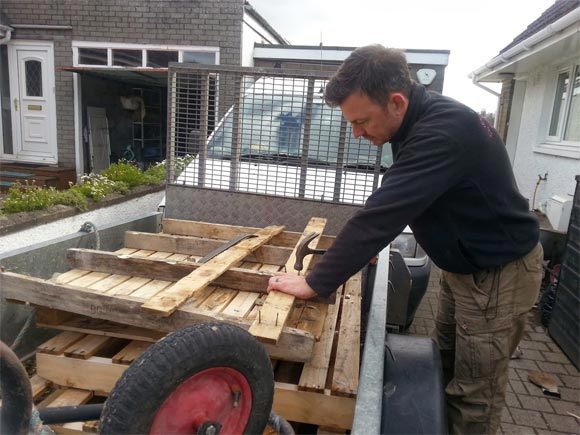
It’s a busy year ahead for Daddy with lots of projects!
So what are your resolutions going to be for 2016?
Lulu xx
What Actually Is Frankincense and Myrrh??
Hey everyone, I am in the school nursery nativity this week! I’m a sheep and my friend Ben is a Wise Man! But have you ever wondered what Frankincense and Myrrh actually are? Well, we have the answer to that (and to be honest, I wouldn’t have been impressed if I was baby Jesus!) as well as some more totes interesting facts on Christmas plants (like why we kiss under the mistletoe) right here…

Frankincense
Frankincense is actually an oily gum resin from the Boswellia sacra tree. The gum was used for religious, medicinal and social uses. And this was a present for the baby Jesus??? Seriously?! I wouldn’t be happy to find an oily gum resin in my stocking on Christmas morning!
Myrrh
Myrrh, or Commiphora guidotti if you want to give it its posh name, is a scented tree native to Somalia and Ethiopia. It has medicinal uses as well as being used as a perfume or incense. Slightly better than an oily gum but still no big girls bike!
Poinsettia
We’ve all seen these red plants EVERY Christmas. But did you know that the flowers aren’t actually flowers, they are something called Bracts. They are also a Euphorbia, a plant which M&D commonly use in the gardens they design. I did not know that! Every day is a school day (well actually nursery for me!)
Holly
Holly, or Ilex aquifolium, is one of the most recognisable of Christmas plants. Don’t eat the berries though as they are mildly toxic.
Ivy
You can’t have Holly without its pal the Ivy. Its posh name in case you want to know is Hedera helix. As well as being useful as winter decoration it is also an important food source for wildlife.
Mistletoe
Mistletoe is commonly found growing on woody shrubs such as apple and pear trees and in wood rows on blackcurrant and hawthorn bushes. But why kiss under it? Well, as the legend goes, the Norse God Balder was killed by an evil spirit with an arrow made of mistletoe. Saddened by her son’s death, Frigga wept tears of white berries, which brought Balder back to life. Frigga was so overjoyed that she blessed the plant and promised a kiss to all who passed beneath it.
So there you go, lots of useless facts to impress your family with over Christmas dinner this year!
Merry Christmas everyone, hope Santa brings you all lovely presents!
Lulu xx
Jack Frost Nipping At Your Rose!
Hey, it’s the 1st of December! Did you all remember to open your advent calendars this morning? Me too, it’s fun isn’t it! December doesn’t just mean advent calendars and Christmas wish lists though. The cold weather is upon us and we have to remember and look after our plants. Here are a few jobs to do over the next few days to protect from Jack Frost…
Protect Your Plants
Some plants are a bit tender and need protection from the cold (bit like my baby sister Tilda!) For instance, we have some blueberries in pots which don’t like being too chilly so we have to wrap them up cosy. We have fleece (horticultural fleece, not like your favourite hoody!) bags and we pop our pots inside one of these and tie them up nice and cosy for the winter.
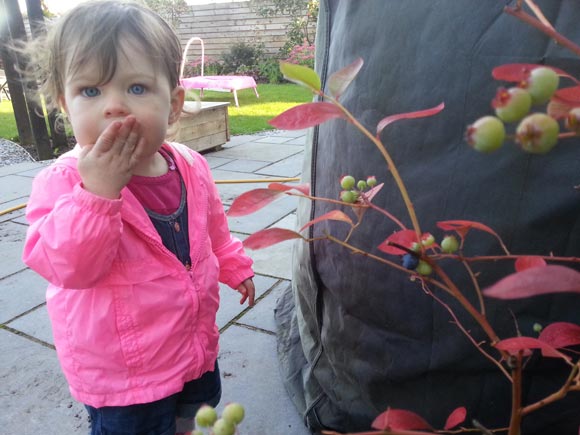
Here’s an ickle me scoffing our blueberries!
If you have other tender/borderline tender plants around the garden, things like tree ferns, some pittosporums, cordyllines etc, then it’s best to protect them too. Wrapping some fleece around them can help a lot. Adding some straw inside the wrapping helps lots too.
Other things you can do to help include:
- Mulching – add a deep layer of organic matter around tender plants to help them keep as cosy as possible. A bit like a cosy blanket.
- Lift really tender plants such as dahlias as they won’t survive the cold weather we have in Scotland.
- Use a cloche on low growing tender plants to protect them and surround them with some grit to help any water drain away quickly. Adding straw can help keep the ground a little warm too.
Avoid Problems
To save a bit of work over winter in future and to be sure your plants will be safe, there are few things to watch out for:
- Avoid golden or variegated leafed plants which can be more tender
- Select plants which are definitely hardy for where you live. You have to be even more careful in Scotland as some plants say they are hardy but actually can’t survive really cold Scottish winters
- Be careful where you plant in your garden. Choose sheltered, south facing corners for any slightly more tender plants.
- Don’t prune old growth over winter as this can provide more shelter (plus one less job to do outside in the winter!)
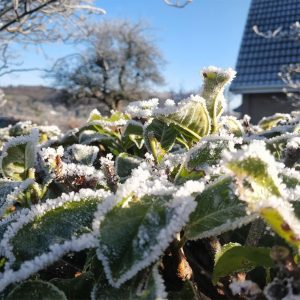
Frost on evergreens
Lastly, but most importantly, once you have done all that work you can head back indoors to the warmth and wrap yourself up in a big fleecy blanket too!
How To Have Fun With A Baby In The Garden…
Hello everyone! Well, it’s a pretty momentous week here at Vialii Towers as my baby sister is about to turn 1!! Yes, can you believe it has been a whole year since I became a big sister? Well, I have learnt a LOT about babies in the last year and I have taken that knowledge along with my gardening expertise to give all you new parents the best list ever of how to have fun with a baby in the garden…
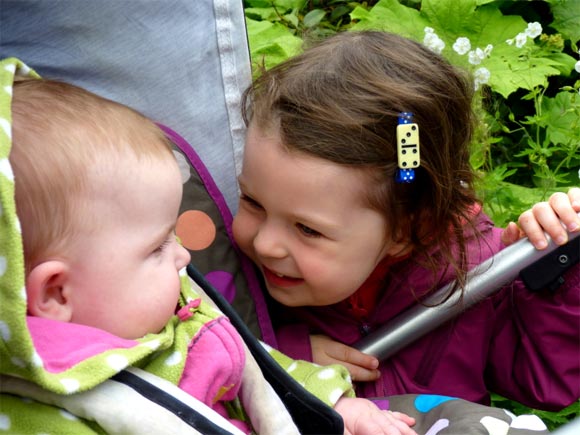
Me and my lovely sister Tilda
Swings and paddling pools and plastic toys are soooo obvious. And not everyone has the space or money for larger toys or want lots of horrible plastic in their garden. Here are my top tips:
POP, POP, POP!
One of Tilda’s most favourite things is bubbles and we will definitely have some at her birthday party! Whether it’s a bubble machine or just a simple pot and wand babies will love watching them fly away in the wind and learn to pop them.

Pop, pop, pop, can you see the bubbles…
WATER LOT OF FUN
You can spend a lot of money on a water table (and I am sure it will be lots of fun) but it doesn’t need to be that expensive. One of mine and Tilda’s favourite things is just a bucket of water and then use some paintbrushes to pretend to paint water pictures on the patio. It’s sometimes fun to bring out a toy tea pot too and fill it with water and have a picnic on the lawn. And we always love watering the plants too!
BEACH BABE
All kids love digging in the sand and babies are no different. They love the feeling between their hands and feet, just be careful they don’t eat it! We were lucky to be built our own sand pit by Daddy but you could use anything. An old baby bath would be perfect as an upcycled sand pit in the garden (or as a water table.) Add some treasure too like foreign coins, conkers, shells etc to be dug up.
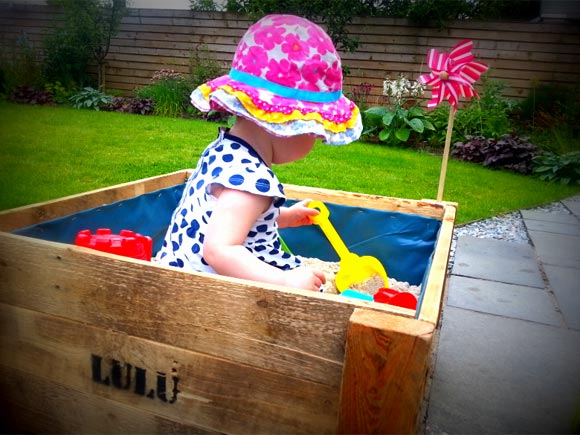
You can make a sandpit out of old pallets if you are clever like Daddy
HOME FROM HOME
A playhouse is a wonderful addition to the garden and we were given a wonderful one by friends who didn’t need it any more and we gave it a bit of a makeover. Have a look on Freecycle or Gumtree to see who wants to get rid of an old playhouse. A lick of paint and some fabric to make curtains and bunting will easily transform it. Or for an even easier and cheaper solution, how about just draping a duvet cover or large blanket over the washing line and making a den? Brilliant!
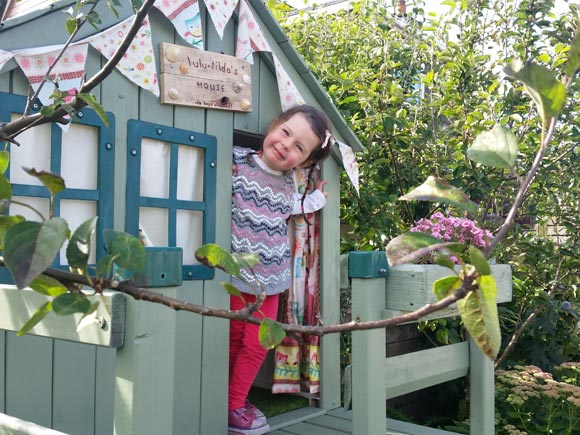
“Lulu & Tilda’s House”
GET THE GARDENING BUG
We don’t always have to resort to toys in the garden. Both Tilda and I have been keen gardeners from a very early edge and could probably use a trowel before we could even use a spoon! Let your babies explore the garden, dig in the borders and have fun getting dirty.
Now Tilda is a big girl, I might even let her do some blogs here too! Happy birthday Tilda, the most wonderful, loveliest, smiliest sister in the world! You’ve passed the test and you can stay!
Lulu xx
Halloween Leaf Ghosts!
It’s Halloween this weekend and I am sure some of you will be hosting Halloween parties or are just decorating your homes to be ghoulish and gruesome. Instead of spending a fortune on decorations from the shop, why not save money and have some fun by creating these amazing Halloween leaf ghosts using autumn leaves. It couldn’t be easier…
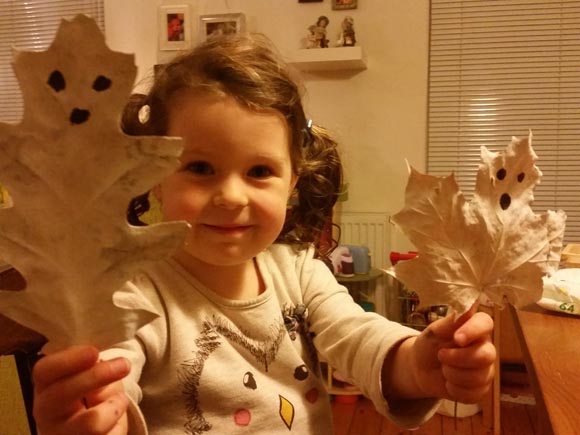
My leaf ghosts
1. Firstly head outdoors and choose some autumn leaves to make your ghosts with. We chose maple and oak leaves as we think they are the best ghost like shapes.
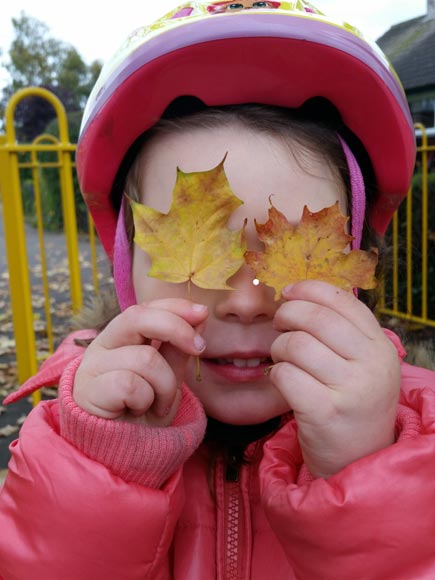
Acer leaves are great for this craft project
2. Make sure the leaves are nice and dry and then paint them white. It may take a few coats of paint to make them really nice and white.
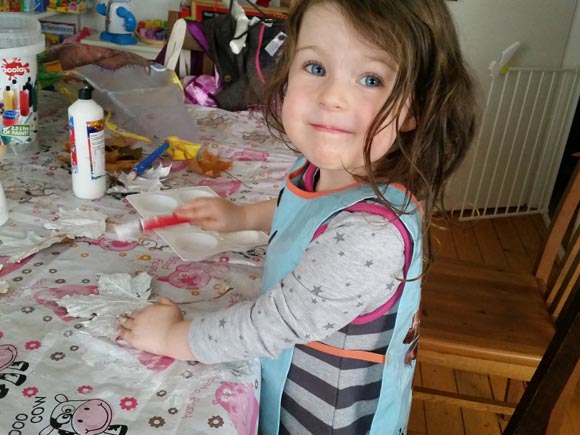
Painting is ALWAYS fun
3. Once the paint is dry simply draw on eyes and a big ghosty mouth.
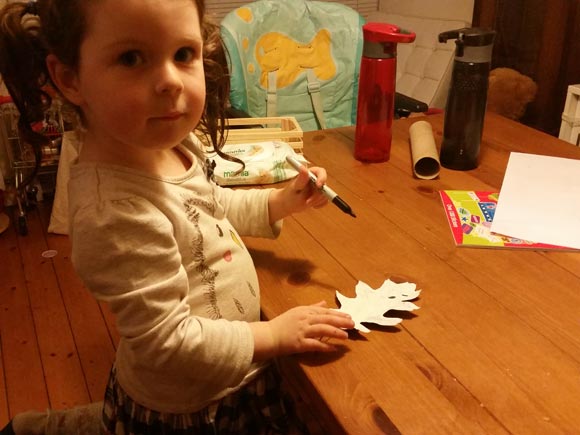
Carefully draw the eyes and mouth
We think if you made lots of these you could make a really fabulous mobile from these leaf ghosts, but remember to paint both sides of the leaf if you are doing this.
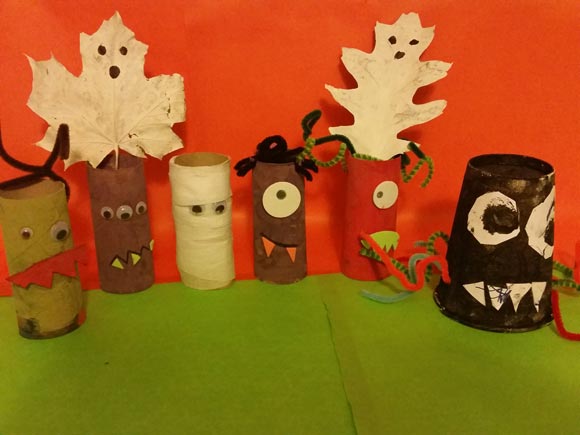
My ghost leaves look great with the other decorations I have made
Happy Halloween everyone!
Lulu xx
A is for Apple Day!
Did you know that today, 21st of October, is National Apple Day? I am glad that the Apple has it’s own special day as they are so yummy and super easy to grow. I should know as I have two apple trees which I can keep a close eye on from my playhouse which nestles cosily in between them. As an apple expert, here are my top tips on the best apples to grow in Scotland…
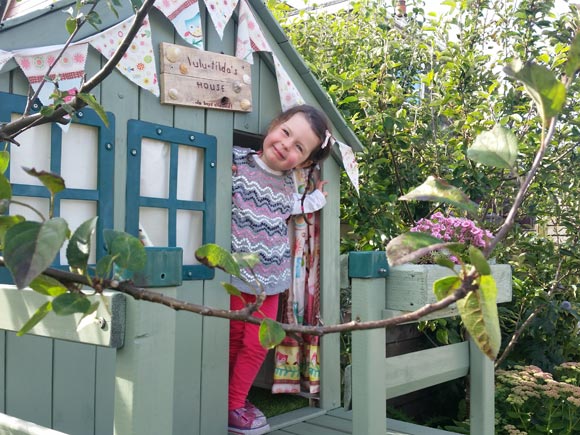
My playhouse nestles in between two apples trees
1. Egremont Russet
Apple ‘Egremont Russet’ is self fertile and easy to grow, making it ideal for gardens where there is only room for one tree. It is the most popular English russet variety.
2. Discovery
The Discovery apple tree is fairly wee (just like me) but always check the root stock of the tree when you are buying (see below). It produces apples quite early in the season, they have a crisp texture and ruby red skins (good for playing Snow White!)
3. Fiesta
Fiesta is one of the best cox style apples and really easy to grow. It is sometimes called the Red Pippin which I think is cute!
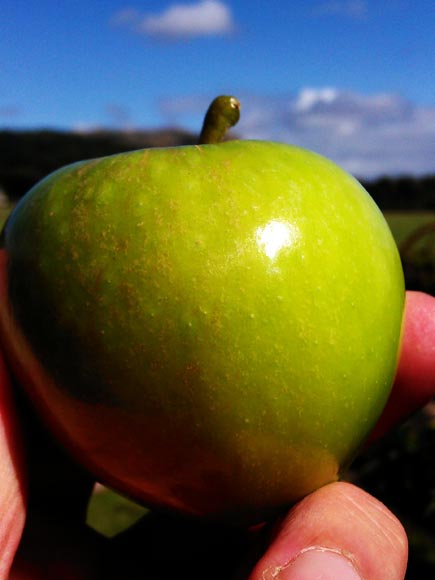
One of our home grown apples
4. James Grieve
James Grieve is the classic Scottish cooking apple but it can also be eaten fresh and is good for juice. Sounds like a fabulous all rounder, just like me!
5. Katy
This is an attractive and easy to grow apple, originally from Sweden and called Katya there. It’s a red eating apple and nice and juicy and great at growing in frosty areas (perfect for us here in Scotland!)
6. Laxtons Superb
These apples come later in the season but they are worth waiting for as they are super yummy and nice and big.
7. Spartan
The Spartan is a small, sweet apple and popular with us kids (I know why, they taste awesome!) Plus they are really easy to grow, bonus!
8. Sunset
Sunset is another cox-style apple and is often preferred over the common Cox’s Orange Pippin as it is much easier to grow. They have a lovely aromatic flavour and the trees are generally not too big.
One of the most important things to look for when you are buying your apple tree is to buy one to suit your garden and how big you want it to get. Always check what the ROOT STOCK is and what size it will become. If you want a smaller tree you will want to consider a dwarf variety for your garden. Many trees are self fertilising so you don’t need to buy two and if you live in an urban environment there is a good chance there will be another apple tree nearby but it’s always best to check to ensure a bumper crop.
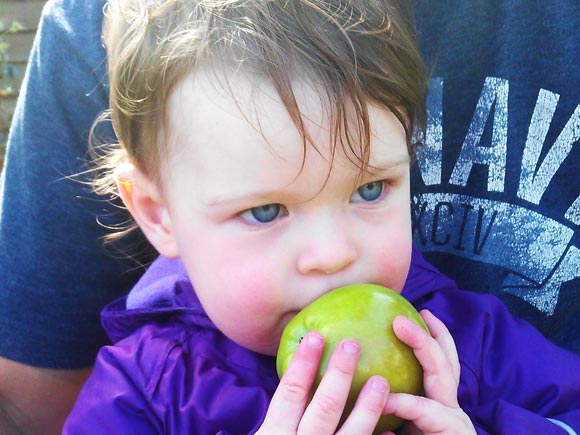
Me when I was littler, eating one of our home grown apples
Now is the perfect time to research what tree you want and get it planted over winter (when they are sleepy, a bit like me!) and you will get some lovely, juicy apples by next summer.
Happy Apple Day everyone!
Lulu xx
Plants & Their Amazing Uses!
Like me, I bet you mainly grow plants in your garden to look pretty or to taste yummy. But did you know plants can have lots of other uses? Read on to find out just what else they can be used for in my blog “Plants & Their Amazing Uses”…
Medicines
Way, way, way back in time (before even Mummy and Daddy were born) plants were the only medicines we had. Clever medicine men and women would gather them to make potions to cure everything from a cold to a sore tummy. 800 years ago there was terrible disease called the Black Death. Hedges were the chemists of the time. People made little posies from the berries and flowers that could be gathered from them and waved them in front of their faces as they thought that would stop them catching the disease. Even though we now know that waving flowers in our faces can’t stop a cold, 1 in 10 of all the really, really important, essential drugs that we use all the time come from plants.

Dr Lulu looking after her poorly Daddy.
Here are just a few examples of medicines made from plants:
- Caffeine comes from the coffee plant and stops big people from falling asleep
- Cocaine from the cocoa plant stops people feeling pain
- The opium poppy contains other medicines to stop pain called morphine and codeine
- Atropine (from plants such as deadly nightshade) helps heart conditions
- Foxgloves contain digitoxin which can help an irregular heart beat
- Quinine (from the fever tree) can help treat malaria
Clothing
A lot of the materials we use to make our clothes come from plants. My favourite cotton dresses come from the cotton plant. It would be a wonderful field to look at if it had pretty pinafores growing in it. Luckily my clever Granny Biscuits can use the cotton fabric and make them into dresses for me! Look out for other natural fibres in your clothing such as hemp or flax. I have even seen bamboo t-shirts!

I can even climb trees in my pretty
Granny Biscuits dresses made from plants!
Fuel
While most of our vehicles run on petrol & diesel, there are alternative fuels out there. Bio-fuels come from crops including corn and soybeans. Bio-fuels are also attractive as they are renewable and have lower emissions. Let’s hope governments make wise choices to support these types of fuels going forward and support the research required to make them cheaper and more widely available.

I am going to ask my Grandpa to run his tractor on bio-fuels
Shelter
Now, we all know the tale of the Three Little Pigs so we know that choosing a house made of sticks or straw isn’t the best option. However, you would be hard pushed to find a house that doesn’t use wood anywhere in its construction so we should appreciate our wonderful trees a whole lot more.
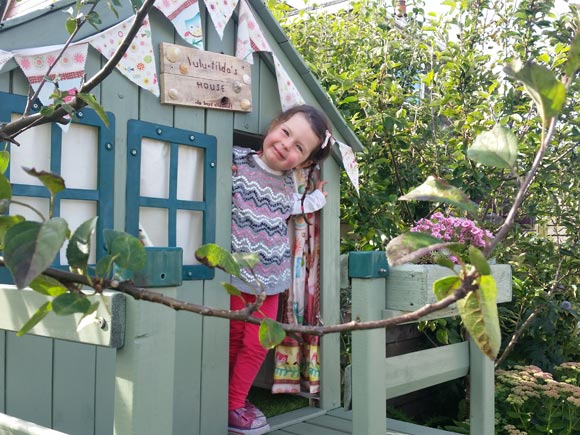
My own house is made from wood (and has cotton curtains!)
So, next time you are out tending to your plants, say thanks to them for being such wonderful things which we simply couldn’t live without.
Lulu xx
Garden Playhouses, The Vialii Way!
If you are an avid follower of our blogs (and why wouldn’t you be?!) then you will be aware that we love a wee upcycling project at Vialii. And these projects are my VERY favourites that we have ever tackled. Welcome to the Vialii Garden Playhouse Makeover!
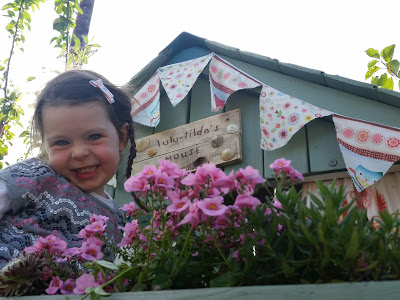
I LOVE my new playhouse!
M&D are designing a garden for friends at the moment and tucked away in a corner of their garden, no longer used, was a playhouse which these (very lovely!) friends said we could have. As this saved Daddy the job of making our own playhouse, he now had the time and energy to help me and Mummy give it a bit of a makeover.
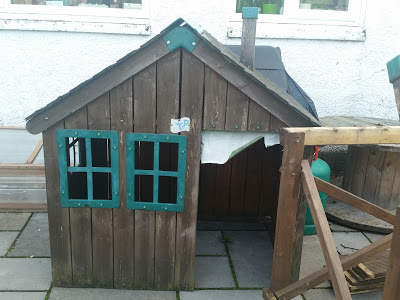
Before: the playhouse needed a bit of Lulufication (yes, that IS a word!)
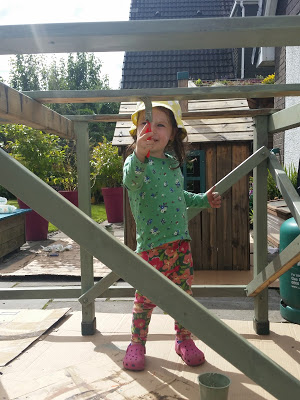
Here I am busy painting my playhouse
We tucked the playhouse in one of our borders so that it doesn’t take up too much space. We just needed to move a few plants.
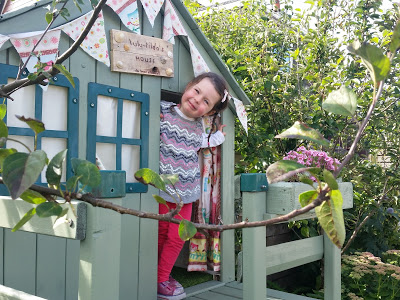
The new playhouse is tucked in the border between two apple trees
The view from inside is lovely, across the garden the fields and up to the Ochil Hills.
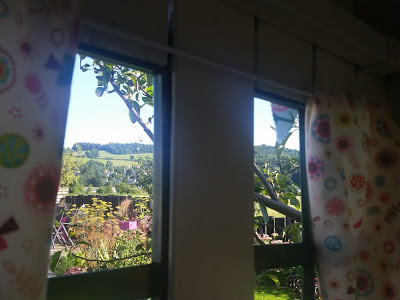
The view from inside my playhouse
My clever mummy made curtains for the windows and door and some bunting for inside and out. I hung a beautiful painting I made at nursery inside and Daddy laid some artificial grass inside which looks like a green furry rug!
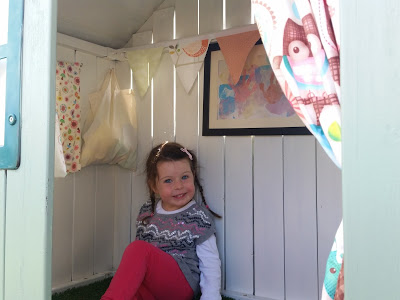
The inside all painted, my furry rug, artwork and curtains!
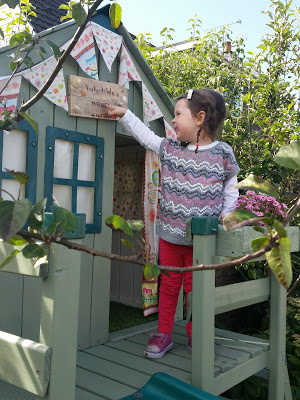
My new sign: Lulu & Tilda’s House, No Boys Allowed!
While we have been very busy at Vialii Towers, my BFF Euan has also been flying the flag for upcycled Vialii playhouses. His clever Daddy has made his from upcycled pallets. Here he is loving his wee house:
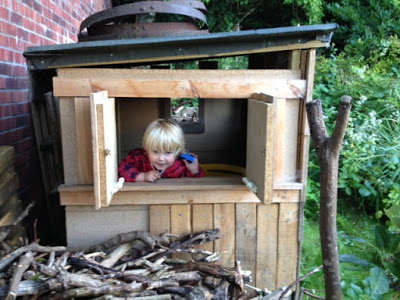
Peek-a-boo
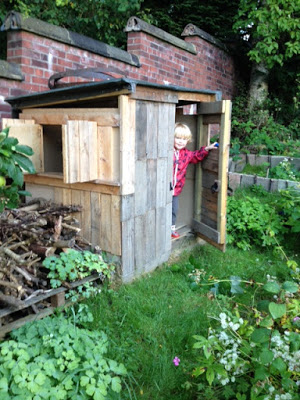
Euan in his wonderful, upcycled playhouse
I’d love to see pics of your playhouses so feel free to share…
Lulu xx
Waste Not Want Not, Compost Style
The nights are getting darker earlier (not that I would know as I’m already asleep way before it gets dark) so it must be getting towards the end of the growing season. So, what do you do with your compost in containers and grow bags once your plants have stopped producing? Read on for my top tips…
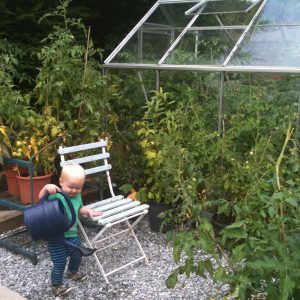
We always have around 100 tomato plants in containers, so have heaps of old compost
The most obvious thing is to just dig the remainder into your borders and raised beds. It seems strange that you can add more compost each year and your beds don’t overflow. It’s the same with farmers spreading muck each year, the fields don’t become skyscrapers either! But if your old compost has been healthy, without any pest or disease problems, there are loads of more interesting and helpful ways you can use it in the garden:
- You can add it to your compost bin in layers with other garden and kitchen waste. This will give your compost a wonderful structure for retaining water and can add some nutrients.
- If you have large containers to fill each year you can fill the bottom with old compost. Weeds won’t be able to grow if they are well buried.

Fill the bottom your tubs with old compost and top up with new
- Sieve your old compost to make a fine seed compost. Seeds don’t need any food from the soil to germinate so the low nutrient levels aren’t a problem. The lighter structure makes it easy for seedlings to push through. This means it is also good for covering outside sown seeds in clay soil where a fine tilth is hard to get. Use it to help level a sloping garden or border.
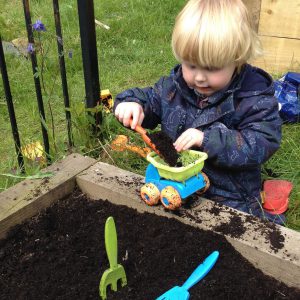
A dumper truck helps cover the seeds with old compost
- Carrots don’t like too many nutrients either or they don’t set good roots. You would end up with lots of small carrots with bushy foliage if you give them too many nutrients. Mix your old compost with some horticultural sand and a bit of fertiliser for happy carrots.You can even reuse the compost to grow a whole new crop of produce. Compost used to grow tomatoes can still be used to grow leafy veg like salad leaves or kale. Just make sure not to try to grow the same crop again as it can lead to pests and diseases building up. It’s crop rotation for your containers. Just add bit of general fertiliser.
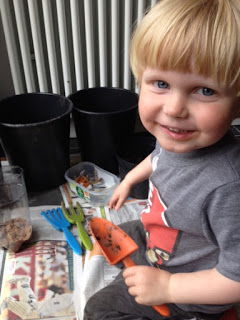
Mix your old compost with sand
and some fertiliser for perfect carrots
- Scatter it over your lawns and rake it in (or let the worms do the work for you as we learnt on my recent blog). This helps add nutrients to the soil below your lawn.Pick out any clumps of roots and scatter it around your borders as a mulch.
Those are my ideas for reusing your old compost, can you think of any others?
You might also be interested in my blog There’s a Worm at the Bottom of the Garden.
Big hugs,
Euan
Is there such a thing as a free lunch?
It’s been a mixed year for us in our veg garden. Potatoes have done well but tomatoes needed more sun. But did you know that if your attempts to grow your own have not gone well, or even if you’ve not got your own garden, you can still get free yummy produce? You just do something called foraging (which sounds like porridge so it must be yummy!)

We’re going on a bramble hunt, we’re gonna find a big one!
Today is the start of the Soil Associations’s Organic September. You don’t get more local or seasonal than picking and eating the edible plants in your local area that haven’t been treated with any chemicals. And way, way, way back in time it’s what all of us would have done to survive, there haven’t always been shops after all!
Getting started
Get know your local area by really, really looking at the trees, hedges and plants that are there and watch how they change with the seasons. Sometimes the yummy things to eat are only there for a week or so, so you need to keep looking. Start by looking for things that are easy to identify and don’t have dangerous lookalikes. So wood sorrel, brambles and elderberries are ideal. I had great fun last year brambling with my BFF Euan, read my blog on it here. And don’t forget the seaside. If you’re lucky enough to live near the sea or are going for a visit, there are heaps of things you can find and eat. How about edible seaweeds like Dulse and Laver? Or seaside plants like rock samphire? The best thing of all about forging for seaweed is that there are no poisonous seaweeds in the seas around the UK.
How to harvest
It’s best not to collect anything from beside busy roads or industrial sites as the plants might be covered exhaust fumes and other nasty chemicals. If you’re foraging for plants that grow close to the ground make sure not to pick from areas where lots of dogs walk as you don’t know where they’ve been having a wee! With most foraging you should cut the plant rather than ripping it. If you just rip up a mushroom you can damage the underground web of special “roots” called Mycelium. It’s the same for seaweed and for other vegetables, don’t pull out the roots but cut the stems. Make sure to wash all of your yummy treasure very thoroughly in lots of running water.
Benefits
Not only is what you foraged free, it often tastes way better than what you buy in the shops. Not convinced? Have you ever tried a wild strawberry? They are teeny tiny but have a much stronger taste than farmed ones and are still to be found out in the wild until September. You also get to taste fab new flavours from things you never get to buy in shops. And of course you don’t need to do all the planting, weeding and watering that us experienced gardeners have to do in our gardens!
What’s in season now?
There are lots of things you can forage for now and in the next few months, some I bet you’ve never thought of looking for or eating. Here’s a list of just a few that should be easy to identify:
- Crab apples (Sep-Dec)
- Elderberries (Aug-Oct)
- Wild horseradish (May- Nov)
- Junipter berries (Aug-Feb)
- Rosehips (Sep-Dec)
- Wild fennel (Apr-Nov)
- Seabuckthorn (Sep-Oct)
- Chickweed (All year)
What not to do
Only ever eat a plant from the wild if you are 100% sure of what it is (and that it’s safe to eat). So ALWAYS make sure an adult who does know how to identify the plants has told you it is ok to eat a plant before you munch on it. There are 10 poisonous wild mushrooms in the UK so mushroom foraging should be left those who really know how to identify the edible ones. Remember that wild plants don’t belong to you so don’t pick every one of them. You need to leave some for other people but you also need to leave some so that the plants can survive and grow year after year. And you need to leave plenty for other foragers like bees and birds. Some greedy people have been taking all of the wild mushrooms in the New Forest and selling them to make money (which is illegal). This is a bit mean on other people who might want pick and eat a few and is killing the fungi so they won’t be there in the future.
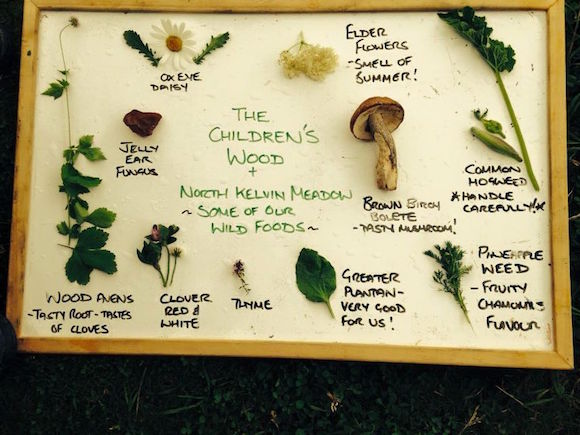
All of these yummy wild foods were found on a recent forage in Glasgow’s Children’s Wood
Well I’ve spotted the first ripe brambles so I’m off to see if Euan can come out to play and help me forage for some.
Oh, I have a blog about that, click here to read it!
Lulu xx
